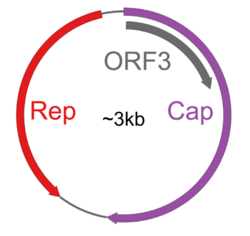Biology:Redondoviridae
| Redondoviridae | |
|---|---|
| Virus classification | |
| (unranked): | Virus |
| Realm: | Monodnaviria |
| Kingdom: | Shotokuvirae |
| Phylum: | Cressdnaviricota |
| Class: | Arfiviricetes |
| Order: | Recrevirales |
| Family: | Redondoviridae |
| Genus and species[1] | |
| |
Redondoviruses (members of the Redondoviridae) are a family of human-associated DNA viruses.[2] Their name derives from the inferred circular structure of the viral genome (“redondo” means round in Spanish). Redondoviruses have been identified in DNA sequence based surveys of samples from humans, primarily samples from the oral cavity and upper airway.[3][4][5]
Virology
Taxonomy
Redondoviruses are assigned to a new family by the International Committee on Taxonomy of Viruses (ICTV), the Redondoviridae.[1][5][6]
Classification
The family Redondoviridae is divided into two species, Brisavirus and Vientovirus.[1][5] The names derive from the words for breeze and wind in Spanish (“brisa” and “viento”), denoting the association with the human airway. Multiple strains have been proposed on the basis of viral genome structure.[citation needed]
The redondoviruses are members of the Circular Rep-Containing Single Stranded (CRESS) DNA Virus group.[7]
- Phylum: Cressdnaviricota[8][9]
- Class: Arfiviricetes[8] (Ar from arginine; fi from finger; describes a feature of the Rep protein conserved among viruses in this class)
- Order: Recrevirales[8] (Re from redondoviruses; cre from CRESS)
Genome
The redondovirus genome is circular, and by analogy to other CRESS viruses likely single stranded. Genomes range in size from about 3.0 to 3.1 kilobases. The genome encodes three inferred proteins:[citation needed]
- A Rep protein that likely initiates rolling-circle DNA replication.
- A Cap protein that likely self-assembles to yield icosahedral particles.
- An ORF3 protein of unknown function. ORF3 is entirely encoded within the Cap coding region in a different reading frame.
Epidemiology
Distribution
Redondovirus genomes have been reported primarily from human samples surveyed using metagenomic DNA sequencing. They have been found primarily in oral and airway specimens.[4][5]In some human populations, oral samples can show up to 80% Redondovirus positivity.[10]
Analysis of a variety of human-derived sample types showed a strong positive correlation of Redondovirus DNA and DNA of the oral amoeba Entamoeba gingivalis. Follow up studies showed that a xenic culture containing Entamoeba gingivalis and feeder bacteria was also positive for redondovirus DNA and RNA. Analysis using intracellular cross linking (Hi-C) showed crosslinking of redondovirus DNA to Entamoeba DNA, supporting Entamoeba gingivalis as the host.[11][12]
Disease associations
It is unknown whether redondoviruses cause human disease. Some CRESS viruses are known pathogens, such as porcine circovirus type 2[13]
Redondoviruses have been reported associated with periodontitis. In one study, the levels fell with successful treatment.[5] Abundance of redondovirus genomes has also been found to be high in some intensive care unit patients, and in patients with severe COVID-19.[14] At present the basis of these disease associations is unclear.[1][5]
References
- ↑ Jump up to: 1.0 1.1 1.2 1.3 "ICTV Report Redondoviridae". http://www.ictv.global/report/redondoviridae.
- ↑ Abbas, A; Taylor, LJ; Collman, RG; Bushman, FD; ICTV Report Consortium (January 2021). "ICTV Virus Taxonomy Profile: Redondoviridae.". The Journal of General Virology 102 (1). doi:10.1099/jgv.0.001526. PMID 33258767.
- ↑ Noell, Kristin; Kolls, Jay K. (May 2019). "Further Defining the Human Virome using NGS: Identification of Redondoviridae" (in en). Cell Host & Microbe 25 (5): 634–635. doi:10.1016/j.chom.2019.04.010. PMID 31071291.
- ↑ Jump up to: 4.0 4.1 Cui, Lunbiao; Wu, Binyao; Zhu, Xiaojuan; Guo, Xiling; Ge, Yiyue; Zhao, Kangchen; Qi, Xian; Shi, Zhiyang et al. (November 2017). "Identification and genetic characterization of a novel circular single-stranded DNA virus in a human upper respiratory tract sample" (in en). Archives of Virology 162 (11): 3305–3312. doi:10.1007/s00705-017-3481-3. ISSN 0304-8608. PMID 28707271.
- ↑ Jump up to: 5.0 5.1 5.2 5.3 5.4 5.5 Abbas, Arwa A.; Taylor, Louis J.; Dothard, Marisol I.; Leiby, Jacob S.; Fitzgerald, Ayannah S.; Khatib, Layla A.; Collman, Ronald G.; Bushman, Frederic D. (August 2019). "Redondoviridae, a Family of Small, Circular DNA Viruses of the Human Oro-Respiratory Tract Associated with Periodontitis and Critical Illness" (in en). Cell Host & Microbe 26 (2): 719–729.e4. doi:10.1016/j.chom.2019.07.015. PMID 31071295.
- ↑ Abbas, AA; Taylor, LJ; Collman, RG; Bushman, Frederic D. (14 October 2019). "Create one new family (Redondoviridae) for circular, Rep-encoding DNA viruses" (in en). https://talk.ictvonline.org/files/proposals/animal_dna_viruses_and_retroviruses/m/animal_dna_ec_approved/9352/download.[|permanent dead link|dead link}}]
- ↑ Zhao, Lele; Rosario, Karyna; Breitbart, Mya; Duffy, Siobain (2019), "Eukaryotic Circular Rep-Encoding Single-Stranded DNA (CRESS DNA) Viruses: Ubiquitous Viruses With Small Genomes and a Diverse Host Range" (in en), Advances in Virus Research (Elsevier) 103: 71–133, doi:10.1016/bs.aivir.2018.10.001, ISBN 978-0-12-817722-8, PMID 30635078
- ↑ Jump up to: 8.0 8.1 8.2 Walker, Peter J.. "2019.012D.A.v1.Cressdnaviricota" (in en) (XLSX). https://talk.ictvonline.org/files/proposals/animal_dna_viruses_and_retroviruses/m/animal_dna_ec_approved/9355/download. "Cressdnaviricota Arfiviricetes Recrevirales Redondoviridae"[|permanent dead link|dead link}}]
- ↑ Krupovic M, Varsani A, Kuhn J, Kazlauskas D, Breitbart M, Delwart E, Rosario K, Yutin N, Wolf YI, Harrach B, Zerbini FM, Dolja VV, Koonin EV (2019). "Create 1 new phylum (Cressdnaviricota) including 2 classes and 6 orders for classification of CRESS-DNA viruses.". https://talk.ictvonline.org/files/proposals/animal_dna_viruses_and_retroviruses/m/animal_dna_ec_approved/9355.
- ↑ "Redondovirus Diversity and Evolution on Global, Individual, and Molecular Scales". J Virol 95 (21): e0081721. October 2021. doi:10.1128/JVI.00817-21. PMID 34406857.
- ↑ Keeler, Emma; Merenstein, Carter; Reddy, Shantan; Taylor, Louis; Cobian-Guemes, Ana; Zankharia, Urvi; Collman, Ronald; Bushman, Frederic (December 1, 2022). "Widespread, human-associated redondoviruses infect the commensal protozoan Entamoeba gingivalis". Cell Host and Microbe 31 (1): 58–68.e5. doi:10.1016/j.chom.2022.11.002. PMID 36459997.
- ↑ Kinsella, Cormac; Deijs, Martin; Becker, Christin; Broekhuizen, Patricia; van Gool, Tom; Bart, Aldert; Schaefer, Arne; van der Hoek, Lia (September 16, 2022). "Host prediction for disease-associated gastrointestinal cressdnaviruses". Virus Evol. 8 (2): veac087. doi:10.1093/ve/veac087. PMID 36325032.
- ↑ Meng, Xiang-Jin (January 2013). "Porcine Circovirus Type 2 (PCV2): Pathogenesis and Interaction with the Immune System" (in en). Annual Review of Animal Biosciences 1 (1): 43–64. doi:10.1146/annurev-animal-031412-103720. ISSN 2165-8102. PMID 25387012.
- ↑ "Signatures of COVID-19 Severity and Immune Response in the Respiratory Tract Microbiome". mBio 12 (4): e0177721. August 2021. doi:10.1128/mBio.01777-21. PMID 34399607.
External links
Wikidata ☰ Q85796392 entry
 |


